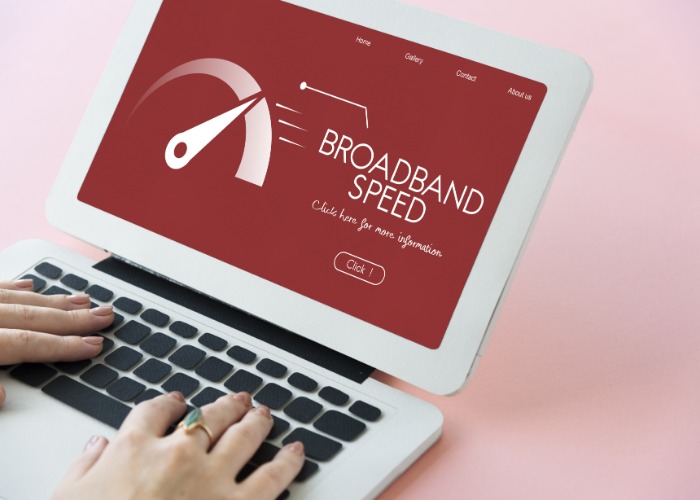Fibre broadband: towns with the fastest and slowest speeds in the UK

New report highlights the areas with the highest and lowest levels of fibre to the premises (FTTP) broadband coverage.
It’s pretty clear now that enjoying decent broadband coverage in your home is little short of essential.
It’s not just the lingering impact of the pandemic, with many of us still working from home for at least part of the week and so reliant on the ability to connect with our workmates online.
No, broadband coverage has become crucial in so many other areas of our life, from smart energy meters to streaming services. Whether it’s work or play, being able to get online is crucial.
However, people across different areas in the UK can have markedly different experiences when it comes to internet connectivity.
Some places enjoy incredible speeds and a reliable service, while for others there’s a greater reliance on older and less effective systems.
So which areas are the best for broadband speeds? A new report from the broadband gurus at ThinkBroadband looks to establish just that.
The importance of full fibre
One of the big factors in the speed you’re likely to get from your broadband connection is how that connection actually works.
The fastest is called FTTP, which stands for fibre to the premises.
It basically means that the infrastructure connects your home directly to the broadband exchange through fibre optic cables.
This setup means you can benefit from the very highest speeds compared with less ideal options like fibre to the cabinet or FTTC.
This means that the fibre cables connect the broadband exchange to a box on your street, but your home is then connected to that box through copper cables, meaning the speeds you can access drop off.
The ThinkBroadband report digs into which areas of the UK enjoy the greatest ratio of FTTP coverage, meaning that local residents are best placed to benefit from the highest speeds on offer.
The best towns for broadband speeds
According to the report, these are the 10 local authorities with the highest levels of FTTP coverage.
|
Authority |
Full fibre coverage |
|
Kingston upon Hull |
99.73% |
|
Belfast |
94.85% |
|
Coventry District |
93.07% |
|
Milton Keynes |
92.64% |
|
Ards and North Down |
92.37% |
|
Derry and Strabane |
91.22% |
|
Lisburn and Castlereagh |
91.09% |
|
Antrim and Newtonabbey |
90.78% |
|
Mourne and Down |
90.46% |
|
Mid and East Antrim |
89.65% |
First off, it’s worth commenting on the extraordinary rollout of full-fibre in Hull.
The city already enjoys near-universal coverage, setting it head and shoulders above most areas in the UK.
Another important point to take from this table is the performance of Northern Ireland.
When considering which nation within the British Isles is most likely to have significant full fibre rollout, it might not be the obvious answer, and yet as we can see from this top 10 list, it is rather leading the way.
In fact, according to the report, it has 89.33% full fibre coverage, compared with around 44% for both Scotland and Wales and 46% for England.
The worst areas for broadband speeds
What about the other end of the table though, the authorities where you’re least likely to encounter full-fibre broadband?
Here’s how the bottom 10 look according to ThinkBroadband.
|
Authority |
Full fibre coverage |
|
Na h-Elleanan an Iar |
5.88% |
|
Argyll and Bute |
5.81% |
|
Gosport District |
5.72% |
|
Enfield |
5.70% |
|
Rossendale District |
5.62% |
|
Woking District |
5.32% |
|
Shetland Islands |
4.44% |
|
Copeland District |
3.38% |
|
Orkney Islands |
2.74% |
|
Isles of Scilly |
2.61% |
Now, some of the names on this table aren’t particularly surprising.
Given the remoteness of places like the Orkneys or the Isles of Scilly, it isn’t exactly a great shock that they don’t yet have much in the way of full fibre coverage.
There are others that are more egregious in their presence, though. Enfield is in north London ‒ it’s just off the M25 for goodness sake ‒ so there is no such ‘remote’ excuse for its lack of coverage.
The same goes for Woking ‒ there seems little reason why such an otherwise connected area of the country should be languishing so poorly when it comes to internet speeds.
How much are we paying for our internet coverage?
Of course, a big consideration when it comes to our internet service is just how much we end up paying for the connection.
Indeed, cost has become an even bigger consideration given the cost of the living crisis, and the fact that April will see a host of providers hiking the prices of their broadband deals.
ThinkBroadband has also dug into the data on this, breaking down the average costs based on the speeds on offer.
Here’s how they compare:
|
Average download speed |
Average monthly cost |
|
50-80 mbps |
£25-£30 |
|
150 mbps |
£27-£30 |
|
500 mbps |
£31-£45 |
|
One gbps |
£41-£49 |
As you can see, the differences in speeds can be pretty significant, with very little actual difference in the price you pay.
In other words, so long as your local area enjoys the right fibre coverage, you may be able to secure a cracking deal that doesn’t cost much more than you would pay for more pedestrian speeds.
It’s worth bearing in mind that the advertised speeds and cost are not the only factors that you need to take into account when determining which broadband deal to go for.
You also need to do your homework on the level of customer service on offer, and how reliable the service truly is.
That’s why it’s worth keeping an eye on the latest complaints figures published by Ofcom, which we always monitor here on loveMONEY.
Comments
Be the first to comment
Do you want to comment on this article? You need to be signed in for this feature

